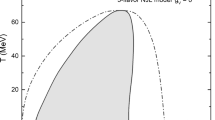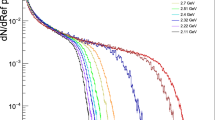Abstract
Experimental results obtained by studying the azimuthal anisotropy of final states in nucleus-nucleus interactions at the energies of the relativistic heavy-ion collider (RHIC) are systematized. The medium is found to exhibit a pronounced collective behavior, which is likely to be formed at an early, parton, stage of the spacetime evolution of product hot and dense matter. Experimental data on the azimuthal anisotropy indicate that strongly interacting matter produced in the final state under extreme conditions behaves as a nearly ideal liquid rather than an ideal gas of quarks and gluons. The experimentally observed suppression of high-transverse-momentum jets and substantial modification of jetlike azimuthal correlations in heavy-ion collisions suggest that the energy loss of partons propagating in high-temperature matter featuring a high density of color charges is extremely large. The dependence of the amount of hardjet suppression in nucleus-nucleus collisions on the orientation of a jet with respect to the reaction plane was first discovered experimentally at RHIC. A strong suppression of the production of high-transverse-momentum particles and jets at RHIC is a unique phenomenon, which was discovered experimentally at lower energies.
Similar content being viewed by others
References
M. Harrison, T. Ludlam, and S. Ozaki, Nucl. Instrum. Methods Phys. Res. A 499, 235 (2003).
T. Ludlam, Nucl. Instrum. Methods Phys. Res. A 499, 428 (2003).
L. D. Landau, Izv. AN SSSR, Ser. Fiz. 17, 51 (1953).
STAR Collab. (J. Adams et al.), Phys. Rev. Lett. 92, 062301 (2004).
STAR Collab. (J. Adams et al.), Phys. Rev. C 72, 014904 (2005).
STAR Collab. (J. Adams et al.), Phys. Rev. C 73, 034903 (2006).
PHOBOSCollab. (B. B. Back et al.), Phys. Rev.Lett. 97, 012301 (2006).
NA49 Collab. (C. Alt et al.), Phys. Rev. C 68, 034903 (2003).
J. Brachmann et al., Phys. Rev. C 61, 024909 (2000).
M. Bleicher and H. Stöcker, Phys. Lett. B 526, 309 (2002).
STAR Collab. (J. Adams et al.), Nucl. Phys. A 757, 102 (2005).
PHENIX Collab. (K. Adcox et al.), Nucl. Phys.A 757, 184 (2005).
R. A. Lacey and PHENIX Collab., Nucl. Phys. A 698, 559c (2002).
STAR Collab. (C. Adler et al.), Phys. Rev. C 66, 034904 (2002).
R. Stock, J. Phys. G 30, S633 (2004).
PHOBOS Collab. (B. B. Back et al.), Phys. Rev.Lett. 94, 122303 (2005).
STAR Collab. (B. I. Abelev et al.), nucl-ex/0701010.
P. F. Kolb, J. Sollfrank, and U. Heinz, Phys. Rev. C 62, 054909 (2000).
PHENIX Collab. (K. Adcox et al.), Phys. Rev. Lett. 89, 212301 (2002).
PHOBOS Collab. (B. Alver et al.), Phys. Rev. Lett. 98, 242302 (2007).
PHENIX Collab. (A. Adare et al.), Phys. Rev. Lett. 98, 162301 (2007).
H. Ito and BRAHMS Collab., Nucl. Phys. A 774, 519 (2006).
L.-W. Chen and C. M. Ko, Phys. Lett. B 634, 205 (2006).
T. Hirano, Nucl. Phys. A 774, 531 (2006).
C. M. Ko and L.-W. Chen, Nucl. Phys. A 774, 527 (2006).
P. F. Kolb and U. Heinz, nucl-th/0305084.
PHENIX Collab. (S. S. Adler et al.), Phys.Rev. Lett. 94, 232302 (2005).
STAR Collab. (C. Adler et al.), Phys. Rev. Lett. 90, 032301 (2003).
PHENIX Collab. (S. S. Adler et al.), Phys.Rev. Lett. 96, 032302 (2006).
STAR Collab. (J. Adams et al.), Phys. Rev. Lett. 95, 122301 (2005).
PHENIX Collab. (S. Afanasiev et al.), Phys. Rev. Lett. 99, 052301 (2007).
STAR Collab. (B. I. Abelev et al.), Phys. Rev. Lett. 99, 112301 (2007).
P. K. Kovtun, D. T. Son, and A. O. Starinets, Phys. Rev. Lett. 94, 111601 (2005).
PHENIX Collab. (S. S. Adler et al.), Phys.Rev. C 72, 024901 (2005).
PHENIX Collab. (A. Adare et al.), Phys. Rev. Lett. 98, 172301 (2007).
M. Asakawa et al., Phys. Rev. Lett. 96, 252301 (2006).
STAR Collab. (J. Adams et al.), Phys. Rev. Lett. 93, 252301 (2004).
X.-N. Wang, Nucl. Phys. A 750, 98 (2005).
P. F. Kolb, Phys. Rev. C 68, 031902(R) (2003).
BRAHMS Collab. (I. Arsene et al.), Nucl. Phys. A 757, 1 (2005).
PHOBOS Collab. (B. B. Back et al.), Nucl. Phys. A 757, 28 (2005).
STAR Collab. (C. Adler et al.), Phys. Rev. Lett. 90, 082302 (2003).
M. Gyulassy, I. Vitev, and X.-N. Wang, Phys. Rev. Lett. 86, 2537 (2001).
I. Vitev and M. Gyulassy, Phys. Rev. Lett. 89, 252301 (2002).
X.-N. Wang, Phys. Lett. B 595, 165 (2004).
STAR Collab. (J. Adams et al.), Phys. Rev. Lett. 91, 072304 (2003).
PHENIX Collab. (S. S. Adler et al.), Phys.Rev. Lett. 96, 222301 (2006).
STAR Collab. (J. Adams et al.), Phys. Rev. Lett. 97, 162301 (2006).
PHENIX Collab. (A. Adare et al.), Phys. Rev. Lett. 98, 232302 (2007).
STAR Collab. (J. Adams et al.), Phys. Rev. Lett. 95, 152301 (2005).
A. Mischke (for the STAR Collab.), J. Phys. Conf. Ser. 50, 127 (2006).
PHENIX Collab. (S. S. Adler et al.), Phys.Rev. Lett. 97, 052301 (2006).
W. Scheid, H. Müller, and W. Greiner, Phys. Rev. Lett. 32, 741 (1974).
A. K. Chaudhuri and U. Heinz, Phys. Rev. Lett. 97, 062301 (2006).
T. Renk and J. Ruppert, Phys. Rev. C 73, 011901 (2006).
J. Stachel, J. Phys. Conf. Ser. 50, 293 (2006).
I. M. Dremin, Pis’ma Zh. Éksp. Teor. Fiz. 30, 152 (1979) [JETP Lett. 30, 140 (1979)]; Yad. Fiz. 33, 1357 (1981) [Sov. J. Nucl. Phys. 33, 726 (1981)].
I. M. Dremin, Nucl. Phys. A 767, 233 (2006); 785, 365 (2007).
A. Majumder and X.-N. Wang, Phys. Rev. C 73, 051901(R) (2006).
I. Vitev, Phys. Lett. B 630, 78 (2005).
N. Armesto, C. A. Salgado, and U. A. Wiedemann, Phys. Rev. Lett. 93, 242301 (2004).
CERES Collab. (G. Agakichiev et al.), Phys. Rev. Lett. 92, 032301 (2004).
PHENIX Collab. (S. S. Adler et al.), Phys. Rev. C 76, 034904 (2007).
V. A. Okorokov and K. V. Filimonov, in Proceedings of the VIII International Workshop on Relativistic Nuclear Physics: from Hundreds MeV to TeV, Dubna, 2005 (JINR, Dubna, 2006), p. 165.
V. A. Okorokov, nucl-th/0611005 (2006).
V. A. Okorokov, Candidate’s Dissertation in Mathematics and Physics (Mosc. Inzh. Fiz. Inst., Moscow, 1996).
J.-Y. Ollitrault, Phys. Rev. D 46, 229 (1992); 48, 1132 (1993).
S. Voloshin and Y. Zhang, Z. Phys. C 70, 665 (1996).
A. M. Poskanzer and S. A. Voloshin, Phys. Rev. C 58, 1671 (1998).
R. S. Bhalerao, N. Borghini, and J.-Y. Ollitrault, Nucl. Phys. A 727, 373 (2003).
Author information
Authors and Affiliations
Corresponding author
Additional information
Original Russian Text © V.A. Okorokov, 2009, published in Yadernaya Fizika, 2009, Vol. 72, No. 1, pp. 155–168.
Rights and permissions
About this article
Cite this article
Okorokov, V.A. Azimuthal anisotropy and formation of an extreme state of strongly interacting matter at the relativistic heavy-ion collider (RHIC). Phys. Atom. Nuclei 72, 147–160 (2009). https://doi.org/10.1134/S1063778809010177
Received:
Published:
Issue Date:
DOI: https://doi.org/10.1134/S1063778809010177




